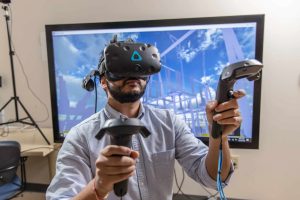Augmented Reality (AR) has come a long way since its early inception in the 1990s. Fast forward to 2025, and AR is no longer a novelty—it’s a key component of how people interact with technology, businesses, and the world around them. Leveraging advancements in AI, 5G connectivity, and AR-specific hardware, this technology is changing how we live, work, and play.
But what is AR now, and how does it differ from related technologies? More importantly, why is AR dominating conversations about innovation in 2025? This blog explores the evolution, advantages, applications, and future potential of AR, offering a clear understanding of why it’s reshaping our world.
Understanding Augmented Reality (AR)

What Is Augmented Reality (AR)?
At its core, AR is a technology that overlays digital content—such as images, text, or sounds—onto the real world through devices like AR glasses, smartphone apps, or AR-compatible contact lenses. Unlike Virtual Reality (VR), which immerses users in a fully virtual world, AR enhances the “real” environment with digital elements. Mixed Reality (MR), meanwhile, combines AR’s overlay with VR’s interactivity.
Key Components That Power AR
AR would not thrive without a blend of advanced technologies. Some of the pivotal components that bring AR to life in 2025 are:
- AI-Powered Image Recognition: Identifies and processes digital overlays in real-time.
- AR Cloud and 5G: Delivers seamless real-world-to-digital interaction by ensuring low-latency rendering.
- Hardware Devices: From smartphones to AR glasses and headsets, AR’s success requires convenient access points.
- Geo-Tracking/Spatial Mapping: These map and anchor AR objects in relation to real-world spaces.
AR is not just “cool tech” anymore; it’s the catalyst for impressive breakthroughs across every major sector.
Advantages and Applications of AR in 2025
The versatility of AR in 2025 makes it invaluable for industries large and small. From enhanced efficiency in professional settings to engaging entertainment experiences, AR is everywhere.
Practical AR Applications by Industry
- Education
AR has transformed learning. Students in 2025 use AR to explore virtual dissections in biology, rebuild ancient civilizations in history, and experiment with real-time physics simulations in STEM courses. Hands-on learning is more immersive and scalable than ever.
Example: Platforms like MergeEDU and Google Lens bring fossils to life and provide interactive 3D visual aids for textbooks.
- Healthcare
Surgeons utilize AR overlays during procedures for better precision, while medical students work with AR simulations to practice surgery risk-free. Patients benefit, too, with augmented telehealth, which explains diagnoses visually.
Example: AccuVein AR tools improve IV insertions by visualizing patient veins in real-time.
- Retail and E-commerce
AR-driven “try-before-you-buy” models allow customers to preview furniture in their homes using an app or try on clothes virtually. The purchasing experience is seamless, interactive, and confidence-building.
Example: IKEA Place enables users to design and visualize rooms with virtual furniture layouts.

- Gaming and Entertainment
AR gaming continues to thrive, building off the success of Pokémon GO. Enhanced AR headsets and glasses now enable players to take part in fully immersive, multi-layered adventures in their actual environments.
Example: Niantic’s Lightship platform powers cutting-edge augmented gaming experiences.
Each industry reaps substantial AR technology advantages, including increased productivity, reduced costs, and elevated consumer satisfaction.
The Broader Benefits of AR
Beyond specific industries, AR’s universal advantages include:
- Improved learning and engagement through interactivity.
- Bridging physical-digital gaps for richer customer experiences.
- Encouraging environmentally sustainable “phygital” (physical-digital) events.
The Natural Environment and Augmented Reality
AR’s ability to enhance real-world interaction extends beyond urban spaces—it’s even reshaping how we connect with nature and the natural environment.
- Digital Conservation Efforts
AR apps educate users about endangered species or eco-friendly practices through interactive content. For example, scanning park trails with an AR app might reveal information about plant species native to that area.
- Eco-Tourism and Exploration
Curious about constellations visible only in remote spots? AR stargazing guides can map the night sky. Likewise, hikers use AR overlays to visualize historical reconstructions of ancient caves or wildlife migration routes.
These examples illustrate how AR enhances our understanding and appreciation of the world around us.
Immersive AR Experiences
The immersive experiences of 2025 go beyond mere entertainment—they are redefining user interaction across multiple mediums.
How AR Elevates Immersion
AR doesn’t just provide curated imagery of a virtual world layered on reality; it makes users active participants in digital storytelling. Consider virtual museum tours where portraits “come to life” and explain their historical significance, or AR-equipped classrooms where students curate their own interactive expeditions.
Real-Life Use Case
Sports fans attending live events benefit from immersive AR glasses that overlay real-time stats, replay options, and personalized seat perspectives. This gamification of user interaction revolutionizes not just content consumption but engagement quality.
The immersive nature of AR has caused spikes in retention rates and satisfaction levels across education, marketing, and entertainment.
The Future of AR Technology

Predictions for AR Growth
Here’s what you can expect from AR:
- Smarter Wearables
AR contact lenses could replace traditional AR glasses, offering hands-free interaction.
- Enhanced 5G Integration
Improved connectivity ensures even smoother remote experiences, from surgeries to gaming.
- Mainstream Usage
Just as smartphones became ubiquitous, AR tools are stepping into mainstream accessibility, at home and in the workplace.
Remaining Challenges
However, widespread AR adoption faces hurdles:
- Accessibility remains costly. Though AR hardware has dropped in price, premium solutions still require significant investment.
- Data privacy issues arise as AR collects considerable user environment data that must be protected.
- Overcoming potential user fatigue with overly complex interfaces or AR-specific “clutter.”
Despite these challenges, the trajectory of AR remains clear—it’s powering into a promising future.
Discover a World Enhanced by AR
Augmented Reality in 2025 isn’t just about a better way to use technology; it’s about enhancing how we live, communicate, access information, and experience the world. From immersive AR experiences in education and entertainment to improved healthcare diagnostics and eco-tourism initiatives, AR is a game-changer we can’t ignore.
How has AR reshaped your world? Already exploring its potential or ready to dip your toe in? Now’s the time—engage with this transformative technology and start exploring its possibilities. Who knows? The real and augmented worlds might just converge in ways we’ve only dreamed about.










